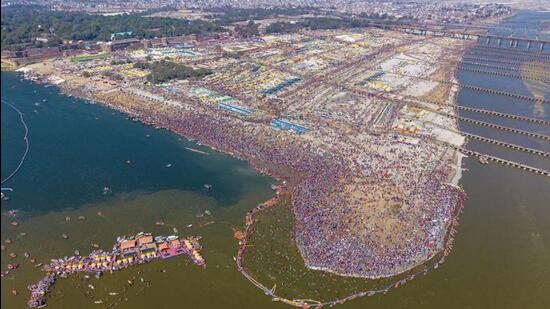Ganga water during Mahakumbh met bathing standards: Bhupender Yadav in LS
Union environment minister Bhupender Yadav also listed a number of initiatives taken by UP government to maintain water quality in Ganga during Kumbh
Union environment minister Bhupender Yadav on Monday said the Ganga water quality at seven locations near Prayagraj, associated with the recently-concluded Mahakumbh Mela, met all standards for bathing during the event.

Yadav was responding to questions by SP MP, Anand Bhadauriya and K Sudhakaran, INC MP from Kerala in Lok Sabha on the quality of water during the mela.
The questions raised by the Opposition lawmakers were, whether the Central Pollution Control Board (CPCB) informed the National Green Tribunal (NGT) that the quality of water at the confluence at Prayagraj, during the Mahakumbh, is failing to meet the primary standards for bathing?; faecal coliform levels from Haridwar to Hugli, location-wise; reasons for such high level of faecal coliform in Ganga water and action taken by the government on the said issue.
“In pursuance of an NGT order in the Kamlesh Singh Vs State of Uttar Pradesh and others, the CPCB carried out regular water quality monitoring at seven locations (twice a week) in the stretch from Shringverpur ghat (upstream of Prayagraj) to Deehaghat (downstream of Prayagraj) including at Sangam nose (confluence point of Ganga and Yamuna) since 12 January, 2025 covering auspicious bathing (Amrit Snan) days including pre and post days of such auspicious bathing days”, the minister informed.
Also Read:Straw burning at Sangam raises pollution alarm in Prayagraj
NGT had directed that, “During the Maha Kumbh 2025 regular monitoring of the water quality of the river Ganga and Yamuna is necessary at frequent intervals to meet primary water quality criteria”.
Yadav informed that CPCB submitted its initial monitoring report dated February 3 before NGT wherein, the river water quality data collected during January 12 to 26 including monitoring data of ten sewage treatment plants (STPs) installed at Prayagraj and seven geosynthetic dewatering tubes (Geo-tube) filtration was reported.
Further, CPCB added three more water quality monitoring locations and increased monitoring frequency to twice daily with effect from February 21 to augment availability of water quality data, thus taking the total number of water quality monitoring locations to 10.
“A comprehensive report dated 28.02.2025 was submitted before Hon’ble NGT in compliance of order dated 23.12.2024. As per the said report, median value of pH, Dissolved Oxygen (DO), Biochemical Oxygen demand (BOD) and Faecal Coliform (FC) for all the monitored locations was within the respective criteria/permissible limits for bathing water,” Yadav said.
Yadav also listed a number of initiatives taken by UP government to maintain water quality in Ganga during Kumbh.
These include 10 STPs installed to treat wastewater; 7 geotubes installed as interim remedial measure for waste water treatment of 21 untapped drains; 3 pre-fabricated temporary STPs installed, each with capacity of 500 KLD in the Mela area; 3 Faecal Sludge Treatment Plants (FSTPs) with total capacity 200KLD; UP Jal Nigam used advanced oxidation techniques to treat wastewater among others.
Yadav did not provide location wise faecal coliform levels.






